

ARTICLES
DOCUMENTS
Marriage License: George William Duning and Dorothy E Hutchings - 12/23/36:
Office of Recorder of Deeds, Kansas City, Missouri in Jackson County; License No. A65440
License # Book-Page: 1936A0065440
 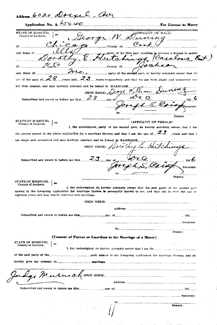
George Duning and Dorothy Hutchings Marriage License in PDF
Source: Jackson County Recorder of Deeds Web Access:
http://records.jacksongov.org/Marriage/SearchImage.aspx |
"George Duning Papers, 1924-1988": University of Wyoming - American Heritage Center.
Collection Details: 9.25 cubic ft. (13 boxes + 2 folders) The George Duning papers include musical scores written by for television and motion pictures including "Picnic," "Beyond Witch Mountain," "Toys in the Attic," "3:10 to Yuma" and many more. The collection also contains audiocassettes and LP sound recordings of Duning's compositions, sheet music and books used for his research, biographical material, unfinished compositions, photographs and newspaper clippings.
http://rmoa.unm.edu/docviewer.php?docId=wyu-ah05044.xml |
LIst of George Duning's Accomplishments - Furnished by Lois Duning
|
"USC Cinematic Arts Library" from University of Southern California, Los Angeles, CA.
George Duning donated his personal scores to USC's famous Film Scoring Program: USC Thornton School Of Music, University of Southern California; Los Angeles, California; The scores are preserved at the USC Cinematic Arts Library that is part of the historic USC Doheny Library. Some scrapbooks and 20 boxes of scores are archived there. (Unfortunately, none of this collection is cataloged and is not available for on-line viewing!).
|
"UCLA Herschel Burke Gilbert Collection #268" from University of California, Los Angeles, CA.
|
George Duning Signed Contract MCA 1962; Contract double signed: "George Duning", and again below, "George Duning" in blue ink, 1 page, 8¼x16½. Beverly Hills, California, May 4, 1962. Employment contract for 5 years between MCA Artists and Duning at the rate of 10%, effective August 15, 1962. Also signed by an Agent for MCA.
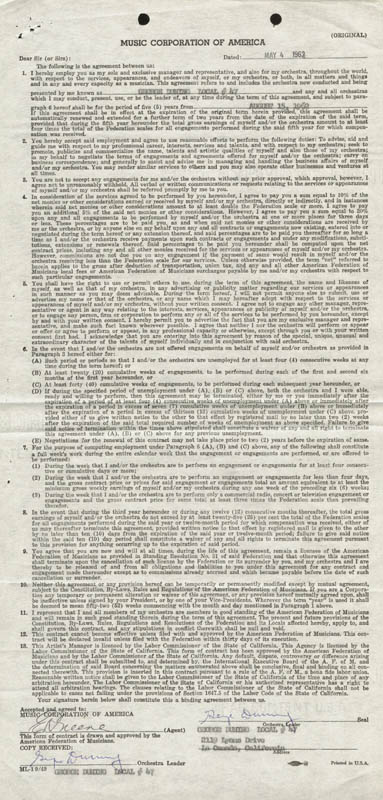
George Duning Signed Contract with MCA 1962: 5 pages of supplementary materials to a concurrently signed contract with Music Corporation of America Contract signed: "George Duning", 5 pages, 8½x11. Beverly Hills, California, May 4, 1962. The documents include supplementary materials and signatures to a concurrently signed contract with the Music Corporation of America which bound Duning to MCA for 5 years, effective August 15, 1962.
  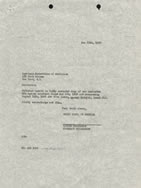  
|
George Duning Signed Letter to "Dear Mike"; Short handwritten letter, 1 page, 8½x11. 2119 Lyans Drive, La Canada, California, 91011; June 12, 1975. On personal letterhead to "Dear Mike", in full:
June 12, 1975
Enclosed is the "biog"
I mentioned to you on the phone -
Will get some tapes etc to you under
separate cover -
Regards,
George Duning

|
George Duning Signed Letter to Film Composer Hugo Friedhofer; This handwritten letter is by film and television composer George Duning to noted film composer Hugo Friedhofer. The letter (signed “George”) is not dated but appears to date from 1959, as Duning is writing about recent Academy Award nominations and thanks Friedhofer for his kind words for Duning’s score of the film Me and the Colonel which failed to garner a nomination. Duning also mentions he will be supporting Friedhofer’s nomination for best Score of a Dramatic or Comedy Picture for the film Young Lions. Written on Columbia Pictures letterhead.
Tuesday
Dear Hugo,
Thanks for "them kind
words you wrote" re. "Me to Colonel" -
I'm with you - I don't understand
the thinking of our colleagues when
it comes to scores at nomination
time - anyway, I'm campaigning
for "Young Lions" -
Best regards for
You & Ginda -
George

|
Ebay Sale: Writer Composer George Duning Hand Signed Original Picnic Song Notes Music

|
Ebay Sale: Note 3/18/20

|
Ebay Sale: GEORGE DUNING. Composer. AMusQS "From Here to Eternity" - his Oscar-nom theme
 ....... .......
|
The Cue Sheet: The Newsletter of the Society for the Preservation of Film Music; Volume 5, No.1 - January 1988
George Duning on the Occasion of the Presentation of the SPFM's Fourth Annual Career Achievment Award--December 16, 1987.
The Cue Sheet is published quarterly by the Society for the Preservation of Film Music. Memberhip information:
10850 Wilshire Blvd., Suite 770, Los Angeles, CA 90024.

|
Borrego Sun Ariticle, 2/10/94, 'EVENING WITH GEORGE DUNING'; Film composer to explain techinigues on 3/13/94 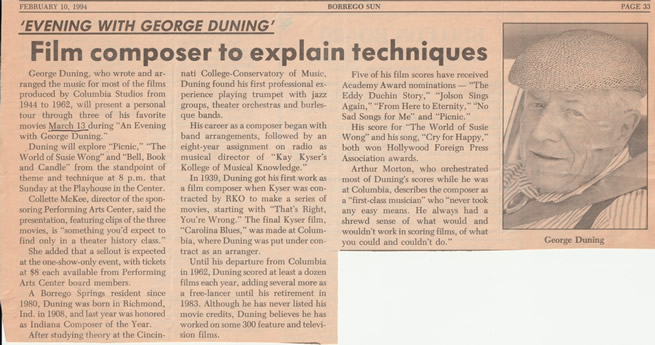 |
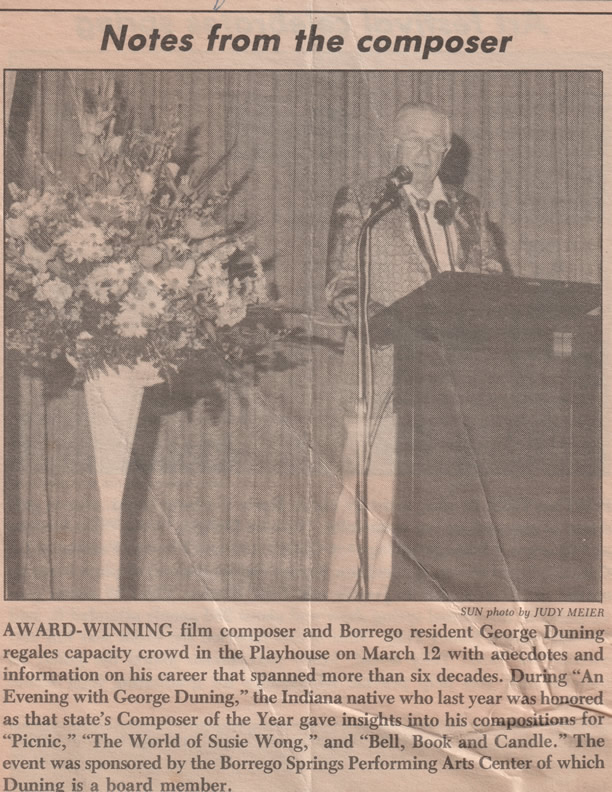 |
The Cue Sheet: Quarterly Journal of The Film Music Society; Volume 23, No.3 - July 2008
Remembering George Duning: George Duning at 100.

|
George Duning Signed Letter to Film Composer Hugo Friedhofer; The letter (signed “George”) is dated February 20, 1959, on stationery of the Screen Composers’ Association. Duning is writing Friedhofer requesting a contribution of $5.00 to offset the unexpected cost of incurred at a recent Screen Composers’ Association dinner, due to the excessive consumption of alcoholic beverages.

|
|
TIDBITS
Updated 9/9/25
George Duning's First Wife Dorothy:
Dorothy (Dottie) E. Hutchings, 8/14/1913—5/3/80; Aged 67;

Born in "other country";
Death place: Los Angeles;
SS 554-76-3036;
Parents:
Father's Surname: Hutchings;
Mother's Maiden Name: Lawrence;
Marriage: (Once)
Children: (3 Daughters): Kathleen, Lorna, Patricia
Grandchildren: (4)
|
George Duning's Second Wife Lois:
Lois Thompson Duning; (3/31/20-12/4/16); Aged 96;

Born: Chicago, Cook County, Illinois
Maiden Name: Lois Thompson
Marriage: (2 Times); John R. Blair & George William Duning
Marriage #1:
John R. Blair: Until his death

John Blair was George Duning's friend and accountant;
Marriage #2:
George William Duning: 2/25/1908—2/27/2000; Aged 92

Married to George William Duning from 3/25/78—2/27/2000; until his death; (About 22 years)'
Married To George Duning in State of California; State File #18283; George was 70 and Lois was 57 (or 65?);
Lois had been a widow, with two children from her previous marriage; a daughter (Christine A. Blair) and a son (John R. Blair); |
Parents:
John R. Thompson (1894-1980)
Lois Bell Thompson (1885-1988)
Children:
John R. Blair
Christine A. Blair
Previous Addresses:
Devonshire House Condos
7811 Eads Ave, Unit #305, La Jolla, CA 92037
1978, George anl Lois moved to a condominium in La Jolla, California at 7811 Eads Ave., Unit 305, La Jolla, California 92037, just a few blocks away from the Pacific coast beaches. (La Jolla is located on the north side of San Diego); Lois lived there until her just before her death on 12/4/16; The property was listed shortly after this time on 3/11/2017 and sold on 4/17/17; Was sold by John R. Blair and Lois T. Duning Family Trust; Buyer was Karen Lindsay; Listing agent: Berkshire Hathaway HomeServices California Properties (BHHS California Properties);
Lois may have spent her last days at Casa de Manana
Casa de Manana Retirement Community
849 Coast Blvd., #101, La Jolla, CA 92037
350-081-19-31 Duning Lois T Family Trust 09-28-92
http://enhancelajolla.org/wp-content/uploads/2016/11/La-Jolla-MAD-ER-v092116.pdf
Latin School of Chicago: Lists Lois passing: Alumni of 1938
http://latinschool.uberflip.com/i/837825-latin-magazine-summer-2017/37
Burial: Lake Forest Cemetery, Lake Forest, Lake County, Illinois; Plot the Thompson mausoleum
Find A Grave Memorial# 192928066; |
George Duning's Three Daughters with 1st Wife Dorothy:
********************************************************************************
Kathleen D. Frankeberger: 7/1/40-4/14/17, Aged 76

Above photo is from Kathy's Facebook page: https://www.facebook.com/kathy.frankeberger
Parents:
George William Duning, (2/25/1908—2/27/2000); Age at death: 92;
Dorothy (Dottie) E. Hutchings, (8/14/1913—5/3/80); Age at death: 67;
Siblings: (2 Sisters); Lorna and Patricia
Husband:
Dennis Lee Frankeberger
Children: (1 Daughter); Melissa Coury
Education:
Immaculate Heart College, Class of 1962; Los Angeles, CA
Loretto Heights College, Class of 1958; Denver, CO
Immaculate Heart High School, Class of 1958; Los Angeles, CA
Residences:
Hometown: La Canada Flintridge, CA
Port Townsend, WA; Glendale, CA; Montrose, CA;
Employment:
Kathy taught primary grades for 23 years for Los Angeles Unified Schools. She stated that she "took millions of hours of art classes for teachers" while teaching.
She loved photography and was very fond of cats, so she spent time working with computer software to transform cat photos into works of art. She operated a web business called "Fix Your Kitty" (fixyourkitty.com site is now closed);

More info
********************************************************************************
Lorna Duning McComsey: 5/15/42-7/20/97, Aged 55; Died in La Jolla, CA.

Above photo is from St. Charles Borromeo Academy in San Diego where Lorna taught the 4th grade class in 1987-88 ;

https://www.findagrave.com/memorial/221552771/lorna-mccomsey
Parents:
George William Duning, (2/25/1908—2/27/2000); Age at death: 92; Died from breast cancer;
Dorothy (Dottie) E. Hutchings, (8/14/1913—5/3/80); Age at death: 67;
Siblings: (2 Sisters); Kathleen and Patricia
Husband:
James T. McComsey; for 33 years, from 7/1964 until her death in 1997;
Graduated from the United States Air Academy, Class of 1964;
http://classof1964usafa.org/McComsey_James/history.htm
Children: (2)
Residences:
Hometown: La Canada Flintridge, CA
La Jolla, CA;
When Lorna and James finished their educations in June 1964 in Colorado, they got married the next month in La Canada near George’s home. When James left the Air Force in 1979 after 15 years of service he and Lorna settled in La Canada for the next 7 years. George moved to La Jolla in 1986. James and Lorna also moved to La Jolla in 1986, always living within 6 blocks of George's condo.

More info
********************************************************************************
Patricia A. Brayton: (79), 4/21/46

Parents:
George William Duning, (2/25/1908—2/27/2000); Age at death: 92;
Dorothy (Dottie) E. Hutchings, (8/14/1913—5/3/80); Age at death: 67;
Siblings: (2 Sisters); Kathleen and Lorna
Husband:
William T. Brayton;
Children: (1 Daughter), Amy Holloway
Residences:
Hometown: La Canada Flintridge, CA
Port Townsend, WA;
Patricia
operated a rental property that she called "The Bird's Eye Carriage House" located at 1633 Spruce Street, Port Townsend, WA 98368 just 3 blocks from Fort Worden State Park;
Patricia also offered a 56' traditional gall schooner called "The Belle" for film, video and photo shoots;
Patricia lives in Port Townsend, WA.
More info |
George Duning's Daughter Lorna:
10/30/18: Editor: Bob Harris: "Thomas McArdle sent me a correction about the omision of George's daughter Lorna from this website. I have since updated George's site with these details:"
-----Original Message-----
From: Thomas McArdle <thomasfmcardle@gmail.com>
Sent: Tuesday, October 30, 2018 3:37 AM
To: Contact@GeorgeDuning.com
Subject: ERROR IN GEORGE DUNING'S BIOGRAPHY.
The biography failed to list George and Dorothy Duning’s third daughter, Lorna. She was born 5-15-42 in Los Angeles (see CaliforniaBirthIndex.org) and died on 7-20-97 in La Jolla. She was married to James T. McComsey for 33 years from July 1964 until her death. They had 2 children, Mark in 1965 and Maureen in 1967.
In 1987-88 Lorna taught the 4th grade class at St. Charles Borromeo Academy in San Diego. My daughter Charlotte was her star pupil. My wife Sylvia was the room mother for that class, and became friends with Lorna. One day, discussing their families, Lorna revealed that her father was a composer, George Duning. Sylvia was surprised because she had heard of George from me. She asked Lorna if she had an older sister. Lorna said yes, her name is Kathy. My wife then surprised Lorna by telling her that I had dated Kathy in college. It was true. Around 1960-61 in Los Angeles I attended Loyola University, Kathy attended Immaculate Heart College, and we met on a blind date with several dates to follow. I met George at that time at his home in La Canada.
I found the omission of Lorna from this biography to be appalling because she was a wonderful person by all accounts, and her life demonstrates she was devoted to her father. When she and James finished their educations in June 1964 in Colorado, they got married the next month in La Canada near George’s home. When James left the Air Force in 1979 after 15 years of service he and Lorna settled in La Canada for the next 7 years. George moved to La Jolla in 1986. James and Lorna also moved to La Jolla in 1986, always living within 6 blocks of George's condo. I suspect Lorna was closer to her father than either of his other children.
I hope you will promptly correct this biography.
|
George Duning's Burial Place:
George Duning, (2/25/1908—2/27/2000); Age at death: 92;
Born in Wayne County, Richmond, Indiana, USA;
Died in San Diego County, San Diego, CA, USA; (two days after his 92nd birthday) at the Alvarado Hospital in San Diego, California; from cardiovascular disease; SS 340-09-7971
Burial: Cremated, Ashes were held by his wife Lois, until her death on 12/4/16. His ashes are now buried with Lois at Lake Forest Cemetery, Lake Forest, Lake County, IL; Plot the Thompson mausoleum. Some of his ashes may have been passed to other family members.

The John R. Thompson Mausoleum
Lake Forest Cemetery:
https://www.findagrave.com/cemetery/106514/lake-forest-cemetery
 ..... ..... 


Find A Grave Memorial# 124622603; |
George Duning's grandfather immigrated from Germany and changed his family name and pronunciation from Dunning to Duning (Dune-ing), since the German pronunciation of Dunning was hard for Americans to pronounce. (Source: Lois T. Duning).
|
George Duning's Previous Homes:
Glendale, California
2119 Lyans Drive, La Canada Flintridge, California 91011
George Duning resided in Glendale, California from 1940 to 1953. (Glendale is located on the north side of Los Angeles).
George then built a house in 1953 located at 2119 Lyans Drive, La Canada Flintridge, California 91011, which became the family home from 1953 - 1978 (25 years). (George had moved out in 1977 after his divorce). (La Canada Flintridge is located on the north side of Los Angeles, just north of Glendale). A single family home with 3 bedrooms, 3 baths, 2,234 sq. ft. on 15,381 sq ft / 0.35 acres.
George built a small studio in the back yard next to the pool.

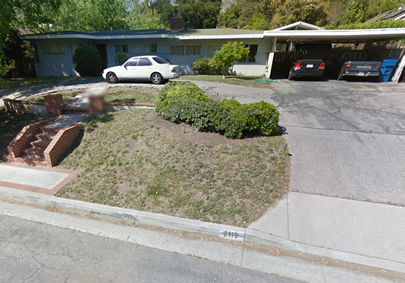
 . .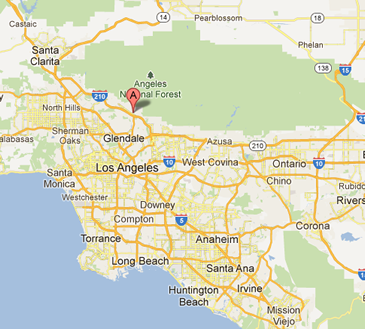
Google Map
La Jolla, California
Devonshire House Condos
7811 Eads Ave, Unit #305, La Jolla, CA 92037
George eventually retired to Borrego Springs, California for the winter months and La Jolla for the summer months. (Borrego Springs is located about 50 miles north-east of San Diego).
 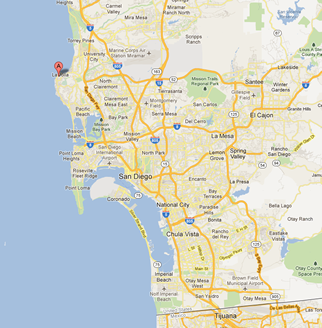
1978, George then moved to a condominium in La Jolla, California at 7811 Eads Ave., Unit 305, La Jolla, California 92037, just a few blocks away from the Pacific coast beaches. (La Jolla is located on the north side of San Diego);
Unit 305: 2 beds, 2 baths; 1,117 sq ft,; Private covered balcony; Parking: 1 space in underground garage; HOA: $475/month; No Cooling & Radiant Wall Heating; Unit is on the 3rd floor, parcel #3500811931;
Building Details: Devonshire Condos: The building has 60 units; Built in 1971, Lot: .65 acres; Style: Mediterranean/Spanish; 5 Floors; Elevator; Underground Parking;
Lois lived there until her just before her death on 12/4/16; The property was listed for sale 3/11/2017shortly after this time on 3/11/2017 and sold on 4/17/17 for $682,500. Price $611 sq/ft;
Google Map
List of George Duning's Previous Homes:
Glendale, California
6202 Drexel Ave., Chicago, IL (this address is listed on George's marriage license in 1936)
2119 Lyans Drive, La Canada Flintridge, CA 91011 - 1953 - 1978 (25 years).
7811 Eads, Ave. Unit 305, La Jolla, CA - 1978 - 2000 (22 Years - until his death). Lois remained there until 12/4/16);
Borrego Springs, California
Other Possibilities:
? 1516 Fairway Ln, Borrego Springs, CA 92004
? 202 Pointing Rock Dr, Borrego Springs, CA 92004
|
George Duning's Passing:
George Duning passed away on 2/27/2000 (he was incapacitated by a stroke and passed away from cardiovascular disease two days after his 92nd birthday) at the Alvarado Hospital in San Diego:
Alvarado Hospital
6655 Alavarado Road
San Diego, CA 92120
http://www.alvaradohospital.com
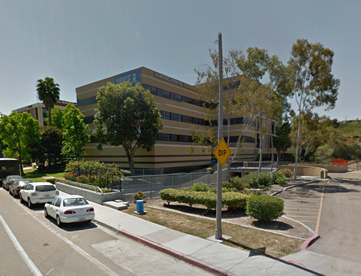 . .
Google Map
|
Borrego Springs Performing Arts Center
590 Palm Canyon Drive
Borrego Springs, CA 92004
http://www.bspac.net/
 . .
Google Map
George Duning served on the Board of Directors of the Borrego Springs Performing Arts Center, at 590 Palm Canyon Drive, Borrego Springs, CA 92004. The original Borrego Springs Movie Theatre was transformed into the present Borrego Springs Performing Arts Center with a seating capacity of 181.
History of the Borrego Springs Performing Arts Center: http://www.bspac.net/script.htm
During the 1950's, the desert community of Borrego Springs was a favorite hideaway for Hollywood stars, including John Wayne, Marilyn Monroe, Clark Gable, Montgomery Clift, Bing Crosby, Will Rogers and James Arness. |
USC Cinematic Arts Library
(part of the
USC Doheny Library)
3550 Trousdale Parkway
Los Angeles, CA 90089
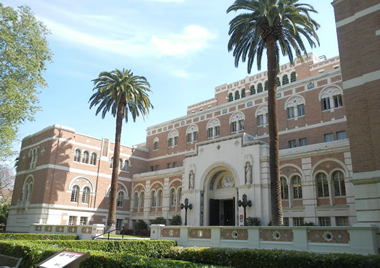 . .
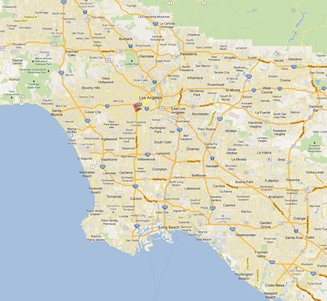
Google Map
George Duning donated his personal scores to USC's famous Film Scoring Program: USC Thornton School Of Music, University of Southern California; Los Angeles, California; The scores are preserved at the USC Cinematic Arts Library that is part of the the historic USC Doheny Library. Some scrapbooks and 20 boxes of scores are archived there. (Unfortunately, none of this collection is cataloged and is not available for on-line viewing!). See above "Documents" link or click here. |
UCLA Music Library
1102 Schoenberg Music Building
Los Angeles, CA 90095-9006
http://www.library.ucla.edu/libraries/music/music-library
The UCLA Music Library has a collection of George Duning items as part of the Herschel Burke Gilbert Collection of Motion Picture and Television Music, (Collection #268). Check out this link for the UCLA H.B.G. Collection #268: http://unitproj.library.ucla.edu/music/mlsc/herschelgilbert.cfm
Click HERE for more details about Collection #268


Herschel Burke Gilbert (April 20, 1918 – June 8, 2003) was a prolific orchestrator, musical supervisor, and composer of film and television scores and theme songs, including The Rifleman (starring Chuck Connors), Dick Powell's Zane Grey Theater, and The Detectives Starring Robert Taylor. Gilbert once estimated that his compositions had been used in at least three thousand individual episodes of various television series. Excerpt from Wikipedia: http://en.wikipedia.org/wiki/Herschel_Burke_Gilbert.
Herschel mentions George Duning a number of times in his interview with Jon Burlingame:
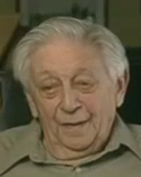
Herschel Burke Gilbert
April 20, 1918 – June 8, 2003
Herschel Burke Gilbert - Archive Interview, 5 parts;
(Interview by Jon Burlingame on April 30, 2001 in Los Angeles, CA)
Full interview: https://interviews.televisionacademy.com/interviews/herschel-burke-gilbert#interview-clips
http://www.laurelrecord.com/herschel_bio.html |
George Duning loved to travel. Some of the places that he liked to visit included London, England and East Berlin, Germany. (Source: Lois T. Duning). |
The American Society of Composers, Authors and Publishers (ASCAP)
http://www.ascap.com/
ASCAP Legislative Fund For The Arts (ALFA)
www.ascap.com/donate.aspx
George Duning made numerous contributions over the years to the ASCAP Legislative Fund For The Arts; $734 from August 30, 1993 to April 3, 1995 and $1318 from December 31, 1990 to May 1, 1996. His last two donations of $265 and $250 were made in 1999.
The ASCAP Legislative Fund for the Arts (ALFA) is ASCAP’s Political Action Committee (PAC). It was established in 1988 as a way of ensuring that the rights of music creators are protected. |
Bimbo's in San Francisco (previously the Bal Tabarin Club)
1025 Columbus Avenue
San Francisco, CA
In 1932, during the midst of the Great Depression, the Duning's band, like many other individuals, journeyed west in search of greener pastures. The group latched on to a lengthy gig at the Bal Tabarin Club in San Francisco, then moved on to the Miramar Hotel in Santa Monica; (The Bal Tabarin in San Francisco (1931–1951) was located at 1025 Columbus Avenue; the building changed ownership to become Bimbo's 365 Club); see Bimbo's website at http://www.bimbos365club.com/.


|
The Blackhawk in Chicago
139 N. Wabash
Chicago, IL
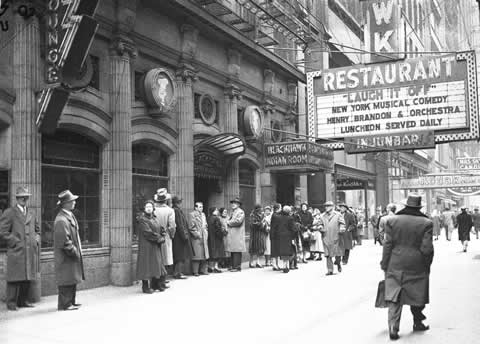
http://chuckmanchicagonostalgia.wordpress.com/2010/03/31/blackhawk-restaurant-scene-in-front-crowd-1952/chicago-photo-blackhawk-restaurant-scene-in-front-crowd-b-and-w-1952/

http://planetbarberella.blogspot.com/2010/12/thursday-evening-otr-for-yaa-march-25.html
After a return engagement at the Bal Tabarin in the fall of 1934, the Kay Kyser Orchestra (that Duning was a part of) got a huge break for steady work work at "The Blackhawk" club in Chicago, IL; The band was a huge hit and scored a contract with Brunswick in the spring of ‘35 for several recordings;
The Blackhawk (139 N. Wabash, Chicago, IL) was a restaurant in the Chicago Loop from 1920 to 1984. It served a menu of American cuisine, notably prime rib and a signature "spinning salad bowl," and was, in the early part of its history a nationally known entertainment venue for Big Band music. (source Wikipedia: http://en.wikipedia.org/wiki/Blackhawk_(restaurant));
Bringing Down The Blackhawk by Bob Knack: (excerpt)
"In 1935, Kay Kyser arrived with Ish Kabibble, Ginny Simms, and Sully Mason. In an attempt to increase typically slow Monday night business at the restaurant, the band settled on the idea of an audience-participation quiz show. It was vocalist Mason who came up with the moniker “Kay Kyser’s Kollege of Musical Knowledge,” broadcast for two hours locally each Monday night. The hit program was eventually bought by Lucky Strike cigarettes, went national on NBC, and had a ticket waiting list in the many thousands.
However, it was in October of 1952 with the Big Band Era over and people now being entertained at home by television, that the music ended forever at the Blackhawk. The bandstand and dance floor were removed and the rolling "Roast Beef Cart" and "Spinning Salad Bowl" took their place. "Food’s the Show" became the slogan as the restaurant continued on until August 31, 1984, when the downtown location closed forever, being replaced for a time by a women’s apparel shop. All the old buildings have come down now near the corner of Randolph and Wabash, replaced with high-rise 'ultra luxury' condominiums. It looks as though the old facades will be incorporated into the new design to give a 'retro' look, at least at street level."
From Jazz Institute of Chicago: http://www.jazzinchicago.org/educates/journal/articles/bringing-down-blackhawk |
Tony Thomas:
Virtually an epitome of the solid, reliable craftsman in the days of high studio productivity, George Duning was for a 17-year period the mainstay composer of Columbia Pictures. During that period, when he proved himself adept at almost every kind of film scoring, Duning was nominated for an Oscar five times for Jolson Sings Again, No Sad Songs for Me, From Here to Eternity, Picnic, and The Eddy Duchin Story.
Born to musician parents, Duning never considered any path for himself other than music. He majored in theory at the Cincinnati Conservatory of Music. He also excelled in playing the trumpet and earned his first money performing with jazz groups and dance bands. Years later he would study composition with the esteemed Italian Mario Castelnuovo-Tedesco, but Duning's first work of writing music came in the popular field, making band arrangements. The next step was radio, where he gained a reputation as a fast and inventive arranger. Duning became the musical director for the Lucky Strike radio program Kay Kyser's Kollege of Musical Knowledge and held that post for eight years. His first film experience came in 1939 when Kyser was contracted by RKO to make a series of movies, starting with That's Right, You're Wrong. The last of the Kyser films, Carolina Blues, was made at Columbia and resulted in that studio putting Duning under contract as an arranger. Soon afterwards he joined the U.S. Navy and spent almost three years arranging and conducting programs for the Armed Forces Radio Service.
After his discharge Duning rejoined Columbia as an arranger and orchestrator but pestered the studio to give him a chance to write original dramatic compositions. His ability in this regard was well proven with Johnny O'Clock, and from then until he left Columbia in 1962 Duning scored at least half a dozen films each year. Thereafter, until his retirement in 1983, he freelanced. He claims never to have made a listing of his scores but estimates that the total number of feature and television films in which he has worked in various capacities probably totals 300. Of these he is especially proud of Picnic, the love theme of which is among the most acclaimed pieces of film scoring; 3:10 to Yuma ; Cowboy ; Bell, Book and Candle ; The World of Suzie Wong ; and Toys in the Attic.
A quiet, modest man, never a seeker of publicity, Duning is particularly well regarded in the Hollywood music community. Arthur Morton, who orchestrated most of Duning's scores during the Columbia years, says, "George never took any easy means. He always had a shrewd sense of what would and wouldn't work in scoring films, of what you could and couldn't do. George is a first-class musician and working with him was a pleasure."
—Tony Thomas
Excerpt from Encyclopedia.com: http://www.encyclopedia.com/doc/1G2-3406802285.html |
George Duning Composed a number of excellent Western Scores:
Here are the western features for which Duning composed the score:
The Man from Colorado (1948)
The Untamed Breed (1948)
The Doolins of Oklahoma (1949)
Lust for Gold (1949)
Man in the Saddle (1951)
Last of the Comanches (1953)
The Man from Laramie (1955)
3:10 to Yuma (1957)
Cowboy (1958)
Gunman's Walk (1958)
Two Rode Together (1961)
Some of Duning’s music (along with other composers’) was also tracked into the westerns “The Law vs. Billy the Kid” (1954), “Masterson of Kansas” (1955), "Buchanan Rides Alone" (1958), "Good Day For a Hanging" (1959), and "Comanche Station" (1960).
|
Kim Novak:
George Duning was under contract with Columbia Pictures for 16 years. During his time there, he was assigned to score 8 feature films starring Kim Novak (who also had a contract with Columbia):

Five Against The House (1955)
Picnic (1955)
The Eddy Duchin Story (1956)
Jeanne Eagels (1957)
Pal Joey (1957 - Duning uncredited)
Bell, Book And Candle (1958)
Strangers When We Meet (1960)
The Notorious Landlady (1962)
|
Film Score Monthly: Film Score Collectors Card #12 - George Duning. One of a total of 36 promotional cards made by the now defunct Film Score Monthly label. Card is 3-5/8" by 4-1/8".
 
|
Georgia State University: Library:
Sheet Music Collections The sheet music database consists of over 12,000 pieces of 19th and 20th century American popular music. It includes published piano-vocal sheet music and Tune-Dex cards (lead sheets on 3x5 index cards). Users may search the database by keyword, song title, songwriter, and year; or browse alphabetically. Additionally, search results can be filtered by format. Detailed information about a piece of music can be obtained by clicking on the song title.
http://library.gsu.edu/music/sheet_music/index.php
|
AFI: Catalog of Feature Films: http://www.afi.com
The AFI Catalog, the most authoritative filmographic database on the web, includes entries on nearly 60,000 American feature-length and 17,000 short films produced from 1893-2011, as well as AFI Awards Outstanding Movies of the Year from 2000 through 2010.
For George Duning: http://www.afi.com/..../George Duning
|

The Trumpet! George Duning's favorite instrument!
George Duning: “I started out originally as a trumpet player, playing both jazz and symphonic music, then I would go back to the Cincinnati Conservatory and take crash courses during the summer. I’d quit the band or wherever I was working and go back and take some theory, counterpoint, harmony, and all that sort of stuff. When I got to the point where I started making arrangements for dance bands, I decided I’d had it as far as a trumpet career goes, so I gave it up."
It is then not surprising to find Duning's very expressive use of the trumpet throughout his music:
Picnic: Hal's Theme
Big Valley: Heath (Sound kind of like Hal's Theme from Picnic?)
The Man From Laramie: Laramie Sample
Houseboat: Houseboat Haven
Then Came Bronson: Freedom on a Motorcycle
|
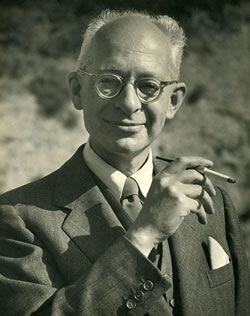
Mario Castelnuovo-Tedesco
http://www.bach-cantatas.com/Lib/Castelnuovo-Tedesco-Mario.htm
George Duning studied composition in Hollywood under Mario Castelnuovo-Tedesco, who was an Italian composer.
Mario Castelnuovo-Tedesco was a significant influence on other major film composers, including Henry Mancini, Nelson Riddle, Herman Stein and André Previn. Jerry Goldsmith, Marty Paich and John Williams are all his pupils.
Mario fled Italy in 1939, shortly before the outbreak of World War II to avoid the fascist Italian government. Over the next 15 years, Mario worked on scores for some 200 films in Hollywood. Mario died in Beverly Hills, California at the age of 72; (4/3/1895 - 3/16/1968). More info about Mairo's biography here (Wikipedia) and here (Answers.com). |
George Duning's Score "STRANGERS WHEN WE MEET":
That score was recorded 56 years ago (1960) at the original Columbia Pictures studio in Hollywood. In the early 1970s, Columbia vacated it, moving everything over to Warner Brothers in Burbank where for several years they rented space and co-existed. The studio was then renamed The Burbank Studios. Then Columbia relocated once again, this time to the former MGM lot in Culver City. The Burbank Studios went back to being called Warner Brothers. That score was conducted by Morris Stoloff on Stage 5 at Columbia. Here's Stoloff conducting on that very stage:
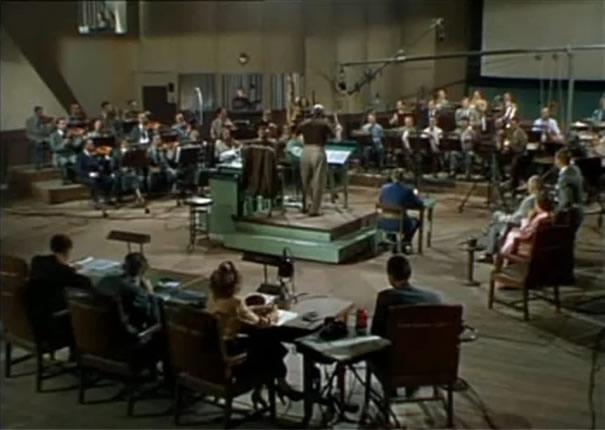
|
John Mansell Quoted George Duning in his 1994 article: "George Duning: A Hoosier in Hollywood" (This links to www.runmovies.eu)
George Duning said:
"While in New York in 1934, I saw a Warner Brothers movie called THE INFORMER, this had a music score by Max Steiner. Up until this time, most movie scores had consisted mainly of excerpts from standard classics, but Steiner had persuaded Jack Warner into letting him compose an original score, tailored to the movie. I was so impressed by what the music did for the film, that I made a resolve that this was what my goal would be in music.”
“Morris [Stoloff] was a fine musician; he was very sensitive to the types of films for which he had to select composers. He was a wonderfully easy man to work with.”
“The producer and director were pleased, and my score [Johnny O'Clock] seemed to work beautifully - my career in movies was on its way,”
“Compared to today's recording facilities, the set-up at Columbia left something to be desired. When Morris was conducting, I was in the recording booth, balancing the orchestra. When I conducted, Arthur Morton supervised the recording.”
“The SALOME score was a very long one for me, and Morris Stoloff felt the background score was very important. It was at my suggestion that he got Daniele to do the dance scene, so I was free to concentrate on the score.”
“Due to low TV budgets, I orchestrated all my TV shows, which included Movies of the Week, THE BIG VALLEY television series, early episodes of STAR TREK… There were a few exceptions however, and at times I would use Walter Sheets as an orchestrator.”
“Josh Logan, for whom I scored PICNIC, wanted to borrow me from Columbia to write the music for SAYONARA, but the producer had accepted a main theme from Irving Berlin. I listened to a demo of the tune and knew that I could never compose a background score upon it, so I turned the film down.”
“I don't like it! [The increased use of synthesizers] The present-day scores that use a predominance of electronic instruments sound cold, robotic, drone-like. I still prefer to hear acoustic instruments.”
“Delmar Daves [for whom he scored 3:10 TO YUMA and COWBOY] was one of the finest directors I ever worked with. We would screen the picture together, spot the scenes that needed musical help, and the rest was up to me, it was a real pleasure.”
“I scored a lot of pictures, and out of my own work, I am particularly fond of PICNIC, BELL, BOOK AND CANDLE, THE WORLD OF SUZIE WONG, 3:10 TO YUMA and some of the early STAR TREK episodes."
“I scored a lot of pictures, and out of my own work, I am particularly fond of PICNIC, BELL, BOOK AND CANDLE, THE WORLD OF SUZIE WONG, 3:10 TO YUMA and some of the early STAR TREK episodes. “Incidentally, I wrote the score for SUZIE WONG while staying in London for three months. Ray Owns was my fine orchestrator on this movie; I fell in love with London then and have been back several times for visits. My wife and I hope to get back for another visit in 1995. Getting back to favorite scores, I would say that I think Hugo Friedhofer's score for THE BEST YEARS OF OUR LIVES is one of the finest ever written.”
“I was never a proficient pianist, some of my best work has come to me in the middle of the night, on a camping or fishing trip, or even sitting at a bar, etc. My themes could be motivated by a title, a line of dialog, a character's name, or by the overall plot of the story.”
“I retired from professional writing in 1983, but I still write occasionally for my own amusement. At the age of 86, I still hear the notes, they never stop. My final comment on my career is, THERE WAS NEVER A DULL MOMENT.” |

Jon Burlingame Quoted George Duning in his 2/25/08 article: "George Duning at 100" (This links to FilmMusicSociety.org)
http://www.usc.edu/schools/music/private/faculty/burlinga.php
George Duning said:
“Less time, lack of budget. In motion pictures, you could have anywhere from 45, 50, 60 musicians on up. In television, if you got an orchestra of 35, you were doing very, very well in those days. So I'd figure out how many cues I could do in three hours with 35 players; and then how many cues I could do in the next three hours, cutting it down to maybe 22 or 23. It was a matter of logistics, figuring out how much money can you get, how many musicians you can use, and for how long. It took a lot of finagling.” |
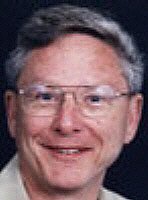
John Stanley Quoted George Duning in his 2000 article: "Celebrating The Rich Legacy Of Film Composer George Duning"
George Duning said:
“It's the best time in a composer's life when you can create without a lot of restrictions, and at Columbia, [Morris] Stoloff allowed the composers to work with a sense of freedom. His attitude was, yes, we'll listen to the producers and directors about what they want the music to be, but ultimately, when it comes time to sit down and write, we must put down what we feel."
"[Morris] Stoloff knew that music was emotion. Get the emotion down on paper and you have achieved your goal. That wasn't always easy, believe me. However, I was always able to sense the emotional content of a film. It was something that was just there for me. At least it lasted long enough for me to get it down on paper." |

Randall D. Larson Quoted George Duning in his 1983 article: "George Duning Remembered"
George Duning said:
“I started out originally as a trumpet player, playing both jazz and symphonic music, then I would go back to the Cincinnati Conservatory and take crash courses during the summer. I’d quit the band or wherever I was working and go back and take some theory, counterpoint, harmony, and all that sort of stuff. When I got to the point where I started making arrangements for dance bands, I decided I’d had it as far as a trumpet career goes, so I gave it up. My teacher at that time, Herman Ogilvie of the Cincinnati Symphony, was training me for the Cincinnati Symphony Orchestra, but in the meantime I’d start playing nightclub dates. In those days, you could take all the pay home, and I wound up finally on the road with dance bands. Eventually I reached a point where I became interested in writing arrangements. I was the musical director, from 1933 to 1944, with the Kay Kyser Band, the old Kollege of Musical Knowledge. In 1944 I went into the Naval Unit of the Armed Forces Radio Service, under Meredith Wilson, and I conducted command performances. I also made I don’t know how many arrangements for personal albums. I wrote original music for propaganda purposes that was used overseas, beamed to Japan. When I got out of the Service in 1946, I decided to take my chances in Hollywood instead of going back to the bands. I went to work at Columbia Pictures first as an orchestrator, and after about eight or ten months, the head of the music department was interested in what I wanted to do, and I told him I wanted to write music for pictures. Finally one day he called me down to the office and asked me how I’d like to do a whole score? In the meantime I had been writing incidental cues for other composers, who were not making their deadlines. The first picture I did was JOHNNY O’CLOCK (1947), with Dick Powell, Evelyn Keyes, Lee J. Cobb. The score was very successful, it was exactly what the producer and the director wanted, and that was the beginning of my picture scoring career."
"I was fortunate. I was able to adapt myself to almost any type of picture score. I’d done psychological dramas, love stories, comedies, Westerns. I love to do Westerns - psychological ones, dramatic Westerns, not the chase type - and I don’t think there’s any type of picture I haven’t done. I’ve done things with jazz scores, symphonic music, touches of rock and roll in the last few years. I’ve adapted myself. To be successful in Hollywood, you have to meet any type of background, which also requires that you have a good background of theory, of musical history. Some of the best times that I can remember in scoring pictures, for instance, were during THE WORLD OF SUZIE WONG (1960), which I did in London. I was over there about twelve weeks. I did a lot of research at the King’s Library for SALOME (1953), which was one of my early scores, looking way back into the Hebraic musical literature before Christ, and then music that came just after the birth of Christ. It’s been fascinating to get into all of these different mediums.”
"My personal approach has always been: When the producer or director calls me in, I ask to be shown the picture without stops between reels. I want to sit through it, and almost every time, I’ll get an immediate feel for it, whether it’s to be a score based on a single long theme, or maybe three or four short pieces of thematic material which will identify characters. Or maybe it’s a picture that calls mainly for sounds of suspense or that type of thing, which is actually not music, per se, but musical sounds. It just depends on the subject matter of the picture. ”
"With the scary-type things they’ve been doing so much of recently, usually with that I’ll use more of a contemporary or even a future-contemporary medium and go in for the dissonances and things like that. I’ve made quite a bit of use in recent years of the electronic sounds, the Yamaha organs and synthesizers, to get the weird sounds. I don’t generally care for most of that stuff, but it does work very well at times.”
"RETURN OF OCTOBER, to me, was a very light film. Terry Moore was the girl, and she was very young on the Columbia lot at that time. Glenn Ford was the actor. To me, that called for a very light touch. Light comedy, not heavy stuff, but very light motives, and so on. THE GUILT OF JANET AMES was something else again. That, to me, called for a very dramatic, heavy theme. I had a long theme, about forty-six bars, which I used almost entirely throughout the picture. Then when Rosalind Russell went into the dream sequences, I would use mixtures of high strings and vibraphones, different types of cymbals, shimmers, and things like that to convey the feeling that the mind was in another strata.”
"[BELL, BOOK AND CANDLE (1958)] That was my favorite. There, again, I felt it needed a good strong theme. Steve Allen later put a lyric to the main theme, ‘Bell, Book and Candle Theme’. I remember I also had short themes, I had a cocky little theme for Jack Lemmon. I had a gimmick for the cat sequence, with Kim Novak, and then if you remember a couple things where Jack would flick his hand and the street lights would go on and off, I worked out what I guess you’d call an electronic device by recording certain sounds on tape and then speeding up the tape, doubling or tripling the speed of the tape and using a variable mixer to raise the pitch into a long “veeeeEEEEEP” type of sound. That was one of the early ones where I tried experiments of that type.”
"I like to stick to the serious, legitimate symphonic style of scoring, on a good solid contemporary story with a good plot and good writing. I think the best example of that is, for instance, Johnny Williams, Leonard Rosenman, they always rely on the strict symphonic sound for contemporary films, with very little of the so-called gimmick sounds electronics, and so forth. To me, it’s still good, legitimate music that will convey the story idea as good as anything.”
"I was fortunate on that. So many producers of those types of shows wanted strictly the far-out sounds, weird effects, the electronic sounds. My producer on that picture was Bob Justman, and he said “I want you to play the story. Forget about any crazy electronic sound effects.” He wanted me to play to the story and not to the fact that it was science fiction.”
"[The TV-movie, GOLIATH AWAITS (1981)] That was, to me, a contemporary thing. There’s an amusing story about that. The producer and the director sat down with me to discuss the approach to the film, and the first thing they both said to me was “we don’t want any water music!” They didn’t want “bubble music!” So there, again, I was able to more or less stick to a conventional symphonic approach.”
"That one was not so much of a theme as an effect, almost like a submersion type of thing that I used for the underwater sequences to build the suspense and excitement. I had a theme for the girl, and I had a theme for the heavy. I had a very nice horn theme for the captain of the undersea group that could be played both in a major and minor mode."
"Frankly, I think one fantasy every year is enough! I enjoy reading a lot of fantasy, though. When I was about fourteen or fifteen years old I spent all my allowance money on Hugo Gernsback’s Amazing Stories magazine, and my parents used to really lay me out, saying 'you’re wasting your money on that trashy stuff! These things’ll never happen!' - you know, trips to the moon and rockets! And now I’ve lived long enough to see it all happen!” |
Doug Verlander -- George Duning’s La Canada Neighbor: (Published 1/11/17)
I remember George well, as his next door neighbor for 21 years!
George built a house in 1953 located at 2119 Lyans Drive, La Canada Flintridge, California 91011, which became the family home from 1953 - 1978 (25 years). [La Canada Flintridge is located on the north side of Los Angeles, just north of Glendale). It is a single family home with 3 bedrooms, 3 baths, 2,234 sq. ft. on 15,381 sq ft / 0.35 acres]. The top of George's house used to be white with white pebbles or rocks on it. It looked like a So Cal wave...blue with a white crest. Google: George's Old House!
My parents lived right next to the Dunings for years. I was only 4 years old in 1955 when my parents moved next door to George, at 2107 Lyans Drive, La Canada, Ca 91011. It was built by Mr. Lyans. My mom lived there until she passed in 2006. It has since been sold and torn down. As I recall it was a relatively new neighborhood. Across the street from Georges there were quite a few vacant lots which were built up over time. I lived there until I graduated from college around 1976, when I was about 26. So I was George’s neighbor from 1955 – 1976, for 21 years.
I first remembered meeting George when he came over to introduce himself. He told my dad that he wrote music and once played the trumpet which my dad and I played. George heard me practicing everyday! At Christmas he would come over with a Christmas gift that as I recall had those soft round cheeses. I remember my dad asked George to play something on my trumpet. He did but was quite out of practice. I was probably the only kid in the world to have George Duning play my trumpet in front of the Christmas tree at my parents on Christmas Day. I've still got the trumpet and mouthpiece!
Over the years they came over for dinner. He and dad talked about big band music. He told us about the Kollege of Musical Knowledge that he was involved with in the past.
As a kid I took care of his pool and landscaping when he was on vacation. He used the pool a lot. George had some great neighborhood pool parties. As I recall, there were only 2 pools in the neighborhood. We had a great time!
And I remember hearing, sometimes all night long, George playing piano in his studio next to the pool. I remember when he would take me into his studio and tell me what he did. Once George had me in the studio and played Picnic. He asked me if I knew the title. I didn't. He then played something else and asked me again. Oh, yeah, that's from Star Trek. He smiled.
I do remember him playing the theme from Bronson! You have to appreciate that I heard him ALL the time. It was like living in an episode! One week it was Big Valley, the next week Star Trek then off to the Orient with Suzie Wong! I got up in the morning and looked for cowboy boots because it was a Big Valley night! From about noon on until very late at night ... 1 AM, 3 AM. And if it was hot (it was LA) he would leave the sliding glass door open to cool the studio off. And my window was open too. The music was then louder! Having the pool was a great break for him.
The studio was nice. I remember a piano and a movie projector and I think a desk and a sofa. I once asked him how he did his work. He played something for me after we watched some scenes on the projector. I remember him saying that certain themes (love, chases, and characters) were a variation of the main theme for the show. He would write something and play it back to the projector. I remember I saw him use a stopwatch and a metronome. I do not remember seeing awards on the wall of the studio. It was right next to the pool and the same color as the house. But I could not just go up to the studio while he was working.
It’s nothing to have music in your ears all of the time. That's probably why I got so interested in radio. I did live in a very large city and Top 40 was very strong (it was invented there)...KRLA, KHJ and KFWB were THE stations. George's music was played a lot on KBIG, a Middle of the Road station. Picnic was played a lot.
I did talk to “Dottie” (George’s wife Dorothy), as everybody called her quite a bit. We had some great conversations. I remember asking her what movies he wrote the music for. She mentioned Picnic and asked me if I ever heard of it. I had to say no! But I was young and it just wasn't for my generation. We talked about lots of things but can't remember any topics. I do remember telling her that I started to collect movie soundtracks and she showed me their collection. I do remember seeing "Dr. No." When she passed, the family went to the service where I remember talking to George.
Dottie once told me he started work about noon, and he went well into the night. I know because I was trying to get to sleep and the piano kept me up. I heard a lot of music from The Big Valley and Star Trek. I don't know the days he worked. Dottie once told me he worked at Columbia and had to go to the studio now and then.
I really didn't interact or play with their daughters, Kathleen and Patricia. They went to Catholic school and I didn't.
The only famous people I remember that visited George were Elmer Bernstein and Mitch Miller. I did go to two parties and there were a lot of Hollywood people there. As I recall once somebody came to the door and asked where George's house was. I called my dad and he told them. When he closed the door he told my mom that he thought that was William Holden at the door!
I became very fond of his music though. Picnic, Houseboat, The World of Suzie Wong (a favorite of mine and can now be viewed on the internet at the Paramount Vault), The Big Valley TV show, The Devil at 4 O'clock, 3:10 to Yuma, From Here to Eternity, and a really old TV show The Naked City.
I have lived in the Midwest for years now. George was from Indiana where I now live. He was not the Hollywood Type. He was very down to earth Midwest. He got the work done. I like that. I have to say that George did have some influence on me and my career. I wrote and SOLD 10 TV scripts after college. He did NOT help me with this. I don't want to mention them. I was a disk jockey in San Francisco for years. Music has always been a major part of my life. My dad really had an influence on me and my trumpet playing.
I liked George a lot!
Doug Verlander <dover46327@sbcglobal.net>
Hammond, IN, USA
Editor: Doug submitted this to me in several stages, with final submission on 1/10/17 |

Film Composer Stu Phillips: George Duning at 100 (Published here on 5/15/11)
Just for the record... As a friend and colleague of George Duning, I would like to add my appreciation of this great composer, but foremost, I would like to let everyone know that this was one of the finest gentlemen I have ever met in the film business.
He was a caring and understanding man who took time away from his busy schedule at Columbia Pictures in 1961 to watch a Columbia Pictures film that I had just composed the music for in New York City. It was my first major film composing job. He subsequently wrote a personal letter to me telling me how well he thought that I had handled the subject matter and that my work was certainly first rate and completely professional.
Upon my moving to California in 1963, he befriended and encouraged me in my career, so far, as to inviting my wife and I to several of his annual Christmas parties at his home.
He is one of the few in the business I can write this glowingly about.
Stu Phillips
http://www.stuwho.com/
Editor: Recieved permission from Stu Phillips to reprint his words here on 5/15/11 |
General Discussion: FILM MUSIC SOCIETY: George Duning at 100
Source: http://www.filmscoremonthly.com/board/posts.cfm?threadID=49070&forumID=1&archive=0
Duning was both a superb composer as well as a very nice gentleman. When we recorded some of his music he went out of his way to help us in any way he could, and even when we weren't working on his music he and his wife Lois were always very friendly. I made him CD copies of his "Manhattan Sounds," a song cycle that he was very proud of and wanted to give to many of his friends. He always let me know how appreciative he was of that.
Duning wrote scores for so many Columbia films that have barely been seen over the years, and it's a pity that more of his music hasn't been released. When we were researching his music at USC we were pleased to see that so many of his written scores were preserved at USC, but it was also sad knowing that because he didn't have "big name recognition," it was unlikely that most of this music would ever be recorded and released.
One of my favorite Duning scores is from the superb TO THE ENDS OF THE EARTH, a 1948 movie about drug smuggling that is sort of a precursor to the James Bond adventures in how it takes you all around the world trying to get the bad guys. Besides all the original scores Duning wrote for Columbia, his music became a very prominent part of the studio's music library, and you can hear endless Duning cues in so many of their films that used tracked music, such as PIRATES OF TRIPOLI, WOMEN'S PRISON, and many of the Columbia film series, such as JUNGLE JIM. While a lot of his album/CD releases focused on his lighter, comedic scores, this was just one small part of his output, as most of the films he scored during his Columbia tenure were serious dramas. I think that if he had worked at a larger studio, with a better reputation for music, he'd be much more highly regarded today, because he was an extremely gifted and versatile composer in so many areas -- not just film music.
An "under the cover of darkness" album slipped out decades ago, containing original tracks from NO SAD SONGS FOR ME, LAST ANGRY MAN, FULL OF LIFE, and COUNT 3 AND PRAY. I have no idea what the source of the music was, but perhaps at some time somebody will rediscover these and other Duning music tracks and give them a proper CD release so that more of his brilliant output can be heard.
MMM |
Remembering George Duning
From: "FINN, BILL" <WILFIN@SAFECO.com> Source: http://www.filmscoremonthly.com/articles/2000/11_Mar---Film_Score_Friday.asp
I was very sad to hear about George Duning, especially that his music was never really re-discovered by many of us before he passed. Along with Alex North, Hugo Friedhofer and Elmer Bernstein he was among the first Hollywood composers to regularly write scores based on an American sound rather than on a European or Viennese one. And the lack of bombast in his music probably helped him extend his career into the '60's. His two Star Trek episode scores of course a lot of us know - they are quite beautiful scores indeed. Unfortunately, like Friedhofer, Ernest Gold and any number of composers who worked kind of in-between the Golden age guys and the Williams/Goldsmith era, his music has mostly been ignored, especially by the record companies. How sad. I was happy to have had the opportunity to meet Duning in 1993 when he was in Indianapolis for 'George Duning Day' (Mr. Duning was born in Richmond Indiana). He gave a short talk about his days at Columbia, dotted with several amusing anecdotes and some film clips. I noted how keen his recollection (and wit) were. He was in his mid-80's at the time, but you wouldn't have thought it after talking with him - he seemed to have a personality that somehow matched the tone of much of his music, understated, funny, engaging and friendly. |
George Duning was incapacitated by a stroke before he succumbed to cardiovascular disease. Patricia Brayton would like you to know, for the sake of your loved ones, to beware of stroke symptoms:
RECOGNIZING A STROKE
STROKE IDENTIFICATION: Remember the 1st Three Letters in STROKE... "S. T. R."
Sometimes symptoms of a stroke are difficult to identify. Unfortunately, the lack of awareness spells disaster. The stroke victim may suffer severe brain damage when people nearby fail to recognize the symptoms of a stroke. Now doctors say a bystander can recognize a stroke by asking three simple questions:
S - Ask the individual to SMILE.
T - Ask the person to TALK and SPEAK A SIMPLE SENTENCE (Coherently) (i.e. It is sunny out today.)
R - Ask him or her to RAISE BOTH ARMS.
If he or she has trouble with ANY ONE of these tasks, call 911 immediately and describe the symptoms to the dispatcher.
New Sign of a Stroke: Another 'sign' of a stroke is this: Ask the person to 'stick' out his tongue.. If the tongue is 'crooked', (if it goes to one side or the other), that is also an indication of a stroke.

|
Here is a good poem for
George Duning: |
When I am Dead, My Dearest
by
Christina Georgina Rossetti
(1830-1894)
When I am dead, my dearest,
Sing no sad songs for me;
Plant thou no roses at my head,
Nor shady cypress tree:
Be the green grass above me
With showers and dewdrops wet
And if thou wilt, remember,
And if thou wilt, forget.
I shall not see the shadows,
I shall not feel the rain;
I shall not hear the nightingale
Sing on, as if in pain:
And dreaming through the twilight
That doth not rise nor set,
Haply I may remember,
And haply may forget.
|
Dark Shadows Album by Robert Cobert


This poem is nicely recited by Jonathan Frid on the
"Dark Shadows" Album by Robert Cobert
(This MP3 audio file is just a short sample from the full track "When I am Dead") |
|
|
|